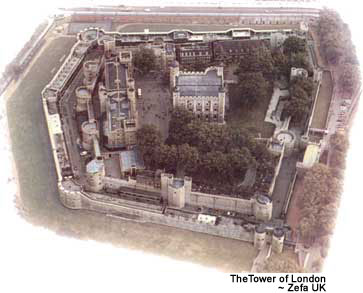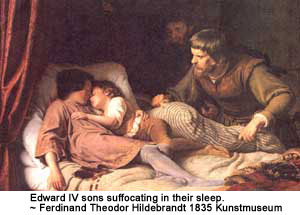Mysterious Disappearance
0n April 9,1483, King Edward IV of England died suddenly just short of his 41 st birthday. His older son and heir was only 12, and in his will Edward had named his younger brother Richard, duke of Gloucester, as protector of the realm.For nearly 30 years the British Isles had been wracked by a dreary civil war between the House of York, which had among its badges a white rose, and the House of Lancaster, symbolized by a red rose. The seesaw contest was later romanticized as the War of the Roses. As the York champion, Edward IV had had the three previous Lancaster kings declared usurpers, but his rule was by no means secure, and he must have known that there would be challenges to his youthful heir, Edward, Prince of Wales.
Richard had proved himself a loyal and resourceful soldier in the service of his brother, Edward IV, and had sworn an oath of fealty to the Prince of Wales. Now he moved quickly to take charge of a realm left with a power vacuum at its center. On April 29, Richard intercepted the entourage taking young Edward to London, arrested the boy's maternal uncle, who "had been in charge," and accompanied his nephew the remaining distance to the capital. The coronation of Edward V, originally set for May 4, was postponed to June 22 as the boy-king was installed in the royal apartments at the Tower of London.
 Suspicious of her brother-in-law's motives, Edward IV's widow, Elizabeth Woodville, sought sanctuary at Westminster Abbey with her younger son and daughters. In mid-June the protector succeeded in persuading Elizabeth to surrender the son, nine-year-old Richard, duke of York, sending word that the boy-king was lonely in the Tower and needed his brother for a playmate there.
Suspicious of her brother-in-law's motives, Edward IV's widow, Elizabeth Woodville, sought sanctuary at Westminster Abbey with her younger son and daughters. In mid-June the protector succeeded in persuading Elizabeth to surrender the son, nine-year-old Richard, duke of York, sending word that the boy-king was lonely in the Tower and needed his brother for a playmate there.Then, on the Sunday that was to have been his coronation day, Edward V was barred from succession. A Cambridge doctor of theology named Ralph Shaa preached a sermon outside St. Paul's Cathedral in London that challenged the legality of the succession. Dr. Shaa claimed that Edward IV was already legally betrothed at the time of his marriage to Elizabeth Woodville, that the union with her was thus invalid under current law, and that their children - including the boy-king were illegitimate. Two days later one of the protector's staunchest supporters repeated the claim before a group of London's leading citizens, adding the lament "Woe is the realm that has a child to their king."
After a brief show of reluctance, the duke of Gloucester accepted the crown on June 26 and was proclaimed Richard III. The boy-king's reign had lasted less than three months.
Accused Richard III
Through July the uncrowned Edward V, now contemptuously referred to as "Edward bastard," and his brother were occasionally seen at play in the Tower yards. But then, according to one contemporary witness, the two boys were taken into the innermost rooms, seen more and more rarely behind barred windows, "until at length they ceased to appear altogether."By the fall of 1483 it was widely rumored that the two princes had been murdered in the Tower - but by whom? In January 1484 the French chancellor warned of the dangers of a minority kingship - the French king, Charles VIII, being only 14. Edward IV's sons, he stated authoritatively, had been killed by their uncle and the crown had thus passed to the assassin.
 Meanwhile, Elizabeth Woodville had forged an alliance with Richard's enemies, offering her eldest daughter in marriage to the Lancaster pretender, Henry Tudor. In August 1485 Richard III met Henry Tudor in battle at Bosworth Field. At a critical moment in the contest one of the king's supporters deserted to Henry, and Richard was killed. The deserter took the crown from the fallen king and placed it on the head of Henry VII. The War of the Roses was ended; England was about to enter a period of unprecedented growth under the House of Tudor.
Meanwhile, Elizabeth Woodville had forged an alliance with Richard's enemies, offering her eldest daughter in marriage to the Lancaster pretender, Henry Tudor. In August 1485 Richard III met Henry Tudor in battle at Bosworth Field. At a critical moment in the contest one of the king's supporters deserted to Henry, and Richard was killed. The deserter took the crown from the fallen king and placed it on the head of Henry VII. The War of the Roses was ended; England was about to enter a period of unprecedented growth under the House of Tudor.As Richard III had been plagued by rumors that he had murdered the princes, now Henry VII was tormented by stories that they were still alive and potential rivals to the throne. Eventually he succeeded in establishing the story that, by order of Richard, the boys had been suffocated under feather mattresses and buried under stones at the foot of a staircase in the Tower.
The convenient scapegoat was one Sir James Tyrell, tried and executed for "unspecified treason" in May 1502. Only later was it announced that Tyrell had confessed to the murder of the princes before his beheading. The tale was accepted and entered the history books with Sir Thomas More's biography of Richard 111, published in 1534 and subsequently used by Shakespeare as a source for his drama Richard III.
Belated Burial
In 1674, some 200 years after the supposed murders, a wooden box containing the skeletons of two children was found during construction work at the Tower of London. Accepted as the remains of the murdered princes, the bones were interred at Westminster Abbey.In 1933 the bones were given to medical experts for examination. The verdict: The skeletons were those of boys the ages of Edward V and his brother at the time of their disappearance. The cause of death could not be established, but the jaw of the elder boy showed a major deterioration.
One of the princes' last visitors at the Tower of London had been a royal physician, called in to treat Edward V's toothache. The boy-king, the doctor reported, had been praying and doing penance daily in the belief that he faced death. "Alas," he said, " I would my uncle would let me have my life yet, though I lose my Kingdom."

